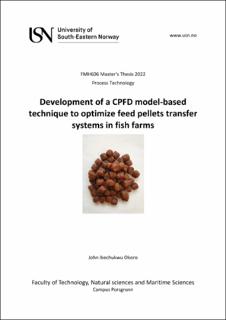| dc.description.abstract | Erosion impact and pellet breakage predictions due to high velocities during pneumatic transport is a cause of concern in the fish farming industry, as it poses a threat to the pipe integrity; leading to increased cost of maintenance due to pipe wear, and environmental pollution resulting from the deposits of microplastics and broken pellets on the seabed.
This study developed a CPFD model using the Barracuda VR® commercial software to optimize the pneumatic transport of 1cm fish feed pellets in an HDPE (High-density polyethylene) pipe using different conveying velocities. Different drag models were tested to establish a base model to observe the pressure drop prediction along the pipe. Using the Wen-Yu and Ergun drag model for the high-velocity tests and the Ergun drag model for the lower velocity tests gave results that are close to the experimental data with acceptable deviations. This model was also used to predict the erosion-prone zones along the pipe and the effect of pipe bends on the hydrodynamics of the transport process.
Results from this study show that an increase in conveying velocity has a direct impact on pipe wear and pellet breakage, simulation results predicted that the highest impact on the pipe wall was at the bend entry position where particles change flow direction, while conducted experiments showed an increase in pellet attrition (breakage). Pressure test and simulation results showed a consistent pressure drop along the conveying pipe accounting for the particle transport through the pipe. The model predicted the hydrodynamics of the gas-solid conveying system, and transport phenomena such as particle roping and vortex formation were observed around the bend region. With a pellet size change from 1cm to 0.5 cm, there was a 27.4% reduction in maximum erosion impact intensity on the pipe wall at a velocity of 32 m/s and a solid loading ratio of 3.24, similarly, increasing the pipe diameter from 7.4cm to 14.8cm for the 1cm pellet resulted in a 94.6% decrease in maximum erosion impact at the same velocity and solid loading ratio. | |
